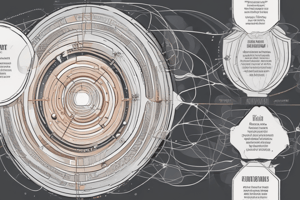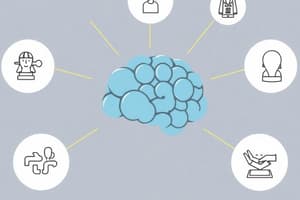Podcast
Questions and Answers
What are the three key elements of motivation?
What are the three key elements of motivation?
Intensity, Direction, Persistence
Maslow's need theory has been frequently researched since the 1960s.
Maslow's need theory has been frequently researched since the 1960s.
False (B)
What are the three needs focused on in McClelland's Theory of Needs?
What are the three needs focused on in McClelland's Theory of Needs?
Need for achievement, Need for power, Need for affiliation
Which of the following is an implication of Self-Determination Theory?
Which of the following is an implication of Self-Determination Theory?
What do specific goals do according to Goal-Setting Theory?
What do specific goals do according to Goal-Setting Theory?
What are the three relationships described in Expectancy Theory?
What are the three relationships described in Expectancy Theory?
When employees perceive inequity, which of the following actions can they take?
When employees perceive inequity, which of the following actions can they take?
Higher levels of job engagement are associated with improved task performance.
Higher levels of job engagement are associated with improved task performance.
What is the Pygmalion effect related to in Self-Efficacy Theory?
What is the Pygmalion effect related to in Self-Efficacy Theory?
What type of behaviors should managers model for their employees?
What type of behaviors should managers model for their employees?
Flashcards are hidden until you start studying
Study Notes
Key Elements of Motivation
- Motivation involves the intensity, direction, and persistence of effort toward achieving goals.
- Intensity refers to how hard an individual tries.
- Direction indicates the orientation that benefits the organization.
- Persistence measures the duration of effort maintained by an individual.
Early Theories of Motivation
- Maslow's Hierarchy of Needs is widely accepted among managers; it is logical and intuitive but has seen limited research since the 1960s.
- Herzberg's theory differentiates between satisfiers and dissatisfiers, though it faces criticism due to reliance on self-reports and lack of a comprehensive measure of satisfaction.
- McClelland's Theory focuses on three primary needs:
- Need for achievement (nAch) – striving for excellence and success.
- Need for power (nPow) – influencing others’ behaviors.
- Need for affiliation (nAfl) – desire for close relationships.
- McClelland's theory enjoys strong support but is challenging to measure due to its subconscious nature.
Self-Determination Theory vs. Goal-Setting Theory
- Self-Determination Theory emphasizes control over actions and intrinsic motivation; extrinsic rewards can diminish intrinsic motivation.
- Providing both intrinsic and extrinsic incentives enhances motivation for organizations.
- Goal-Setting Theory establishes that specific, challenging goals improve performance, and feedback is crucial for achieving higher outcomes.
- Individuals can have a promotion focus (striving for advancement) or a prevention focus (fulfilling duties and obligations).
Self-Efficacy, Reinforcement, and Expectancy Theory
- Self-efficacy reflects belief in one’s capabilities, influenced by:
- Enactive mastery – successful experiences boost confidence.
- Vicarious modeling – learning through others’ experiences.
- Verbal persuasion – encouragement can increase belief in abilities.
- Arousal – physiological state affects performance.
- Reinforcement Theory asserts that behavior is influenced by its consequences, shaping future actions.
- Expectancy Theory connects motivation with expected outcomes, consisting of three relationships:
- Effort-performance relationship – belief that effort leads to performance.
- Performance-reward relationship – expectation that good performance earns rewards.
- Rewards-personal goals relationship – alignment of rewards with individual goals.
Forms of Organizational Justice
- Employees experiencing inequity may react by changing inputs/outcomes, distorting perceptions, choosing different references, or leaving the organization.
- Organizational justice impacts task performance and citizenship behaviors, with significant reactions to perceived injustice.
Job Engagement Implications for Management
- Job engagement reflects the active investment of an employee's energies and is linked to better performance.
- Factors enhancing engagement include meaningful work, alignment of personal and organizational values, and inspirational leadership.
Implications for Managers
- Ensure extrinsic rewards are perceived as informative rather than coercive.
- Encourage employees to set specific, challenging goals and provide feedback on progress.
- Align employee goals with organizational objectives to foster commitment.
- Consider fairness in resource distribution to demonstrate respect and improve motivation and performance outcomes.
Studying That Suits You
Use AI to generate personalized quizzes and flashcards to suit your learning preferences.




